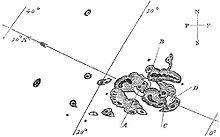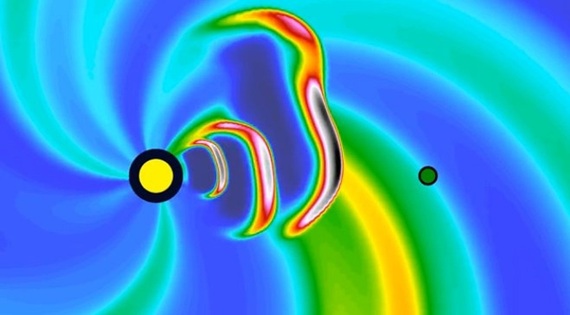There are several types of solar storms that might take place,including . NASA Scientists,UK Astrophysics researchers have been worrying about a phenomena called solar flare that might have enough impact on this planet to keep us worried for at least about 12 hours.
What is a Solar Flare?
A solar flare is a sudden flash of brightness observed over the Sun's surface or the solar limb, which is interpreted as a large energy release of up to 6 × 1025 joules of energy (about a sixth of the total energy output of the Sun each second or 160,000,000,000 megatons of TNT equivalent, over 25,000 times more energy than released from the impact of Comet Shoemaker–Levy 9 with Jupiter). They are often, but not always, followed by a colossal coronal mass ejection.The flare ejects clouds of electrons, ions, and atoms through the corona of the sun into space. These clouds typically reach Earth a day or two after the event.The term is also used to refer to similar phenomena in other stars, where the term stellar flare applies.

NASA Image of 2014 Solar Storm (Solar Flare,to be specific.)
Why Do Solar Flares Occur?
Flares occur when accelerated charged particles, mainly electrons, interact with the plasma medium. Scientific research has shown that the phenomenon of magnetic reconnection is responsible for the acceleration of the charged particles. On the Sun, magnetic reconnection may happen on solar arcades – a series of closely occurring loops of magnetic lines of force. These lines of force quickly reconnect into a low arcade of loops leaving a helix of magnetic field unconnected to the rest of the arcade. The sudden release of energy in this reconnection is the origin of the particle acceleration. The unconnected magnetic helical field and the material that it contains may violently expand outwards forming a coronal mass ejection.This also explains why solar flares typically erupt from what are known as the active regions on the Sun where magnetic fields are much stronger on average.

Sunspots of September 1, 1859, as sketched by Richard Carrington. A and B mark the initial positions of an intensely bright event, which moved over the course of five minutes to C and D before disappearing.
Although there is a general agreement on the flares' causes, the details are still not well known. It is not clear how the magnetic energy is transformed into the particle kinetic energy, nor is it known how the particles are accelerated to energies as high as 10 MeV (mega electron volt) and beyond. There are also some inconsistencies regarding the total number of accelerated particles, which sometimes seems to be greater than the total number in the coronal loop. Scientists are unable to forecast flares, even to this day.
Here is a little excerpt of an article from The Gurdian regarding threats to the communication systems that could last for 12 hours maximum.
“Most coronal mass ejections are not emitted in the direction of Earth,” the report says. “Those that are typically take one to three days to reach us, and we can predict the arrival time to within about six hours. Predictions are currently less accurate due to degradation in the satellite capability available to forecasters.
“Generally speaking, the faster the ejection, the greater the potential impacts. The Carrington event, for example, travelled to Earth in as little as 18 hours. It is therefore likely that our reasonable worst case scenario would only allow us 12 hours from observation to impact.”
The Carrington event is often described as the perfect storm. The modern day effects of a similar event would include localised power outages; disruption of satellite operations, including to GPS and satellite communications; disruption to high-frequency communications; increased radiation to aircrew and passengers in flight, particularly over polar regions; and further disturbances to small-part electronic systems.
According to The Independent,
"The Earth is being battered by a huge solar storm, which could disrupt the power grid and GPS as well as letting people see beautiful auroras.A potent blast of magnetic plasma shot out of the sun on Sunday, travelling faster than usual, according to the US National Oceanic and Atmospheric Administration (NOAA). It brought with it the biggest solar storm at least since March, and perhaps since September 2005."

(Photograph Source)
Computer model of an approaching storm (Credit: NOAA)
According to Dr.Sten Odenwald,astronomer at National Institute of Aerospace,as found in an article on The Huffington Post,Scientifically, we know that strong space weather storms can shut down electric power grids, give you a dose of radiation as you fly to Paris, or shut down that specific satellite that gives you your GPS location or tells you about that snowstorm about to cover your house with a foot of snow. Because humans today are no different in temperament from those who walked the streets a century ago, we can learn a lot about likely human behavior today by looking backwards at how people reacted in previous storms. It's all there, written in the newspaper stories, and a dramatic testament to human misunderstanding, superstition and fear.
But in some cases we see the emergence of breathtaking islands of wisdom and calm. This didn't happen by accident but because scientists painstakingly figured out how the whole space weather phenomenon works. The earliest news reports from the 1800s actually featured a wizened astronomer describing how telegraph outages and the Northern Lights were caused by sunspots. Over the course of a few more decades, instruments were developed that could watch the sun for particularly nasty-looking sunspots and sound an alert. This was especially important during World War II, when the D-Day Invasion was timed to take place when the sun was least active. Once solar physicists and geophysicists got their hands on some very cool data during the Space Age and access to supercomputers, their predictive abilities improved by leaps and bounds. The sun still randomly generates these storms, but now we can give several-day advanced notice.
There is still nothing we can do about these storms other than get our vulnerable technology "out of the way," so when they inevitably happen, you and I will still react to them as humans. A major superstorm capable of taking down our society for weeks or months is still a reality, but like the inevitable Great California Earthquake everyone is waiting for, all we can do is prepare for the worst and hope for the best.








0 Comments
What are your perspectives?